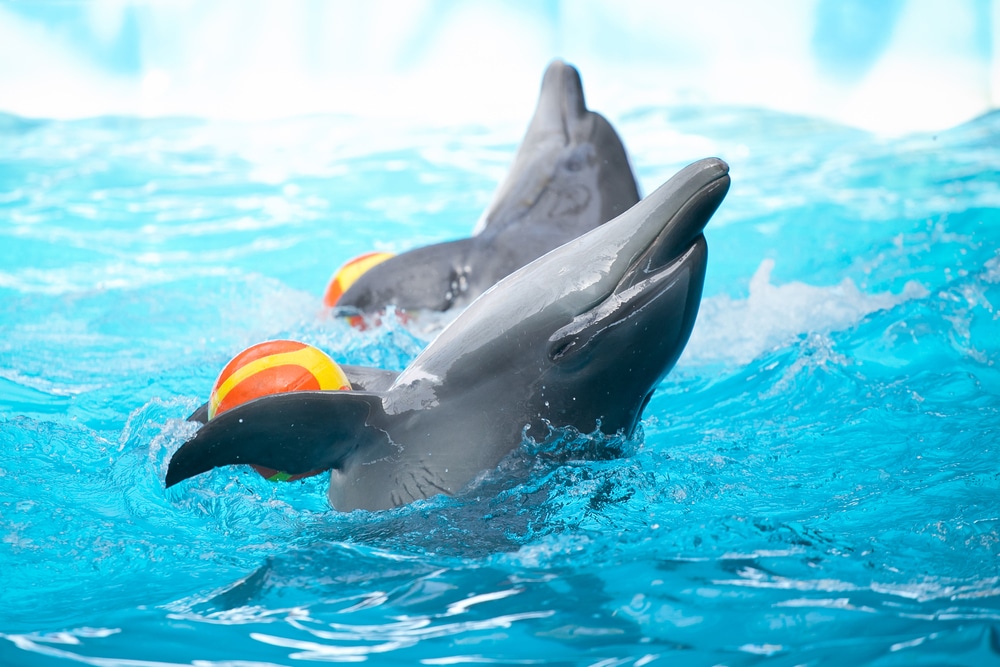If you visit the “Siegfried & Roy’s Secret Garden and Dolphin Habitat at The Mirage” web page, you’ll see what makes this “enchanting world” an exotic, yet family-friendly, amenity. Pictures and video clips feature white tigers sunning themselves on grassy slopes in their enclosures and families in wet suits grinning, their hands resting on a dolphin, for a picture bound to end up framed back home. Visitors can pay to paint with the dolphins, be a “trainer for the day,” and even get centered during “yoga with the dolphins,” where they can practice poses in the underwater dolphin viewing area.

But behind the sheen of such enticing marketing, there lies a darker story. On November 4, the Las Vegas Review-Journal reported that Beetle, one of The Mirage’s 10 performance dolphins, had died at age 12, what was said to be “a relatively young age considering that male bottlenose dolphins live 40 to 45 years.” Further, Beetle is the 15th Mirage dolphin death since 1990 — five of which were stillborn or newborn dolphin calf deaths. Before Beetle, a dolphin named Sgt. Pepper died in 2009, at two years old, from lung infection complications.
Cetacean Rights
Though animal rights debates are complex and longstanding, the rights of cetaceans are perhaps, now more than ever, at the forefront of the public conscience, particularly in light of the provocative documentary Blackfish, released in 2013.
Interestingly enough, SeaWorld Entertainment announced on November 9 that it would be “phasing out” its live orca performance shows at their San Diego park by 2016, shifting instead to a “new orca experience” in 2017 that will include an “informative and natural setting” and a “conservation message inspiring people to act.”
Examining target demographics, SeaWorld has concluded that moms want inspiring, conservation-minded experiences for their children, and Millennials too want to learn something in their travel experiences and are more likely to back cause-driven companies. Thus, one of many reasons to change the structure of their San Diego (not San Antonio or Orlando) park.

Should Dolphins Be In Captivity?
This confluence of headlines once again expands the performance cetacean conversation, inspiring many consumers to consider how they interact with animals in tourism contexts — and the larger question of whether cetaceans should be in captivity to begin with.
In response to Beetle’s death, animal rights advocacy groups were swift and decisive in their stance on this issue. A recent post on PETA’s blog reads:
The cramped concrete tanks at The Mirage and other venues housing captive dolphins—including SeaWorld—condemn these intelligent animals to a lifetime of confinement, forced to swim in their own diluted waste and deprived of everything that is natural and important to them, including the currents, sights, and vastness of the ocean as well as their families and freedom.
Similarly, Adam Roberts, CEO of the nonprofit Born Free USA and the Born Free Foundation, decried The Mirage’s animal exhibit and Beetle’s death in a recent press release:
We now see, more plainly than ever, why this move should never have been approved – and why dolphins do not belong in a cement prison outside a Las Vegas hotel. Even one death is too many, and yet with a death toll of 15 it is abundantly clear that The Mirage is no place for captive wildlife. These remarkably intelligent animals are not ours to use for profit or for entertainment. Every aspect of Beetle’s daily existence – and the lives of the nine that remain – was manipulated for showmanship and profit. He died at a quarter of his natural lifespan without ever experiencing life outside a concrete bathtub.”
The difficulty with animal rights movements, and that of captive cetacean rights, is that the rhetoric of the animal rights community is often discredited by the scientific community as dogmatic, or at least unbacked by compelling data. When presented with the argument that animals like dolphins and whales should not be raised in captivity, many point to the valuable research, and thus data, gleaned from being able to study these animals in captivity. While some scientists propose conducting research in the wild as a more ethical alternative, the argument still stands that research on captive cetaceans has yielded valuable information that would have otherwise been inaccessible.
Scientists like Dr. Lori Marino, a biopsychologist who recently shifted her focus from academia to the nonprofit sector, is seeking ways to bridge the gap between the scientific and animal rights communities. She founded the Kimmela Center for Animal Advocacy “because I saw that a lot of pro-animal exploitation arguments were aimed at discrediting animal activists.” Her work as a scientist, faculty member, and active scholar supports her belief that “there is a lot of power in data and science. I employ evidence–not opinion–to make advocacy arguments. Real evidence, legitimate expertise, academic credentials–all are next to impossible to discredit.” Thus, the Kimmela Center “is about empowering animal advocates with academic and scientific credentials and approaches–something the pro-animal exploitation faction is clearly unequipped to deal with.”
With regards to captive cetaceans in the tourism industry, Marino agrees with the general animal rights consensus: “The one thing we do know is that dolphins and whales cannot thrive in concrete tanks and there is an overwhelming amount of scientific evidence demonstrating this.” Additionally, she notes that “[t]he concern about losing opportunities to do meaningful research with dolphins at theme parks is a nonissue. Very little, if any, research goes on at these places anyway. So the loss of these public displays would not have any significant impact on what we learn about dolphins and whales.”

Alternatives To Captivity
In terms of alternatives to captivity, there are a few compelling options being discussed. PETA suggests that organizations like SeaWorld switch to “stunning cutting-edge virtual reality educational experiences” like that offered by Magic Leap, though the particulars of how this could be accomplished, or even the particulars of what Magic Leap does, remain vague.
A more concrete alternative is ocean sanctuaries, what Marino feels is “the way forward,” though it would mean that “places like SeaWorld would have to change their business model in a fundamental way.”
Popular media undoubtedly plays a large role in this conversation, though Marino believes the concept of cetacean rights (she helped pen the Declaration of Rights for Cetaceans) is often misconstrued. “When we talk about cetacean rights we are not talking about human rights,” she said. “We are talking about the rights that go with being a dolphin or whale–not a human. With that said, I think the media is very important in helping to educate the public and keep momentum on these issues going.”
Responsible Wildlife Tourism
For travelers, she notes that the first step in making an ethical decision about how to encounter wildlife in tourist settings is straightforward: “Tourists and travelers need to know one thing–that if they are paying to swim with or see dolphins or whales confined in tanks that they are contributing to their suffering. The only ethical step is to refuse to buy tickets to any place where the dolphins do not have a choice about being there–and that is almost all of these attractions.”
In the meantime, travelers and consumers can support organizations like the Kimmela Center and consult resources like Responsible Travel to endorse ethical wildlife experiences–not ones curated at the cost of an animal’s wellbeing.
Recommended:
Can Tiger Tourism Be Responsible? [Blog Inspiration]
Voices in the Ocean: A Journey into the Wild and Haunting World of Dolphins by Susan Casey [Must Reads]
Fox 40 Sonik Blast Safety Whistle [Travel Safety]
Latest posts by Paige Sullivan (see all)
- Holiday Treats & Christmas Traditions Around The World - Dec 19, 2016
- Handouts In Developed Nations: Advice For The Responsible Traveler - Jun 7, 2016
- 5 Immersive Culinary Enclaves To Savor In NYC - Feb 18, 2016
- Traveling Responsibly & Protecting Fragile Environments - Jan 9, 2016
- Can Tiger Tourism Be Responsible? - Jan 9, 2016






Dolphins belong to one place in this world ‘The Sea’ where they can socialise with each other, swim freely & breed in peace. They are not for show or to entertain humans & not for greedy people to make $$$$$$$ Show respect for a WILD animal